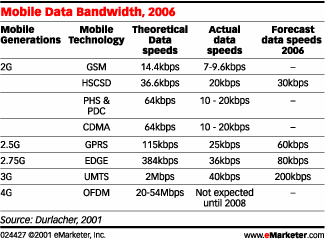 |
|
|
|
By Ben Macklin In the recently published eMarketer Broadband Report, broadband internet was defined as connectivity speeds of 256kbps and higher downstream and a return path of 56kbps or greater, regardless of the device. In the context of mobile wireless devices, the much talked-about third generation (3G) of networks will not fulfill this definition for at least the next five years, according to Durlacher's UMTS Report.
Most mobile wireless operators are now upgrading their networks to provide greater bandwidth to the user. General Packed Radio Service (GPRS), High Speed Circuit Switched Data (HSCSD), and Enhanced Data rate for GSM Evolution (EDGE) are being rolled out at a limited additional cost to GSM providers. The prospects for GPRS in the short to medium term are good because the packet-based connections alleviate network capacity problems and allow operators to offer greater bandwidth and IP-based services and applications to the user. While a rate of 115kpbs is theoretically possible with GPRS, Durlacher suggests that the actual speeds that the user will receive will be closer to 20kbps, which will rise to over 60kbps in 2006. EDGE technology is a further development of current GSM networks, enabling theoretical data speeds of 384kbps. In reality the user will experience 36kbps initially, but this will rise to over 80kbps in 2006 according to Durlacher. Universal Mobile Technology System (UMTS) technologies - 3G - incorporates several different solutions. The two main carrier technologies capable of offering high mobility that meet the criteria set by the International Telecommunications Union for UMTS are wide band Code Division Multiple Access (W-CDMA) and CDMA2000. These 3G technologies have theoretical data speeds of 2Mbps. In reality, however, the actual data speeds that users will experience at introduction will be about 40kbps rising to 200kbps in 2006. This is a far cry from "real" broadband and limits, to a large extent, the services and applications that will be viable and attractive. There are different interpretations as to what 4G technologies are. Durlacher suggests the next step in the development of mobile wireless will be the separation of the up and down link. Tests have been conducted for a system with an EDGE uplink and a wide band Orthogonal Frequency Division Multiplexing (OFDM) downlink. Other possible configurations combine GPRS or UMTS for the up-link and wireless LAN technology for the down-link. Digital broadcasting systems are also becoming more relevant as down-link alternatives. User data rates have been estimated at between 20Mbps - 54Mbps. It is not expected, however, that implementation of 4G networks will begin before 2008 according to Durlacher. While the prospects for mobile broadband are very exciting consumers will probably not see a device that can deliver mobile video streaming at a decent resolution for 5-8 years. That seems like an awfully long time in this environment of exponential technological change.
|
|||||||

